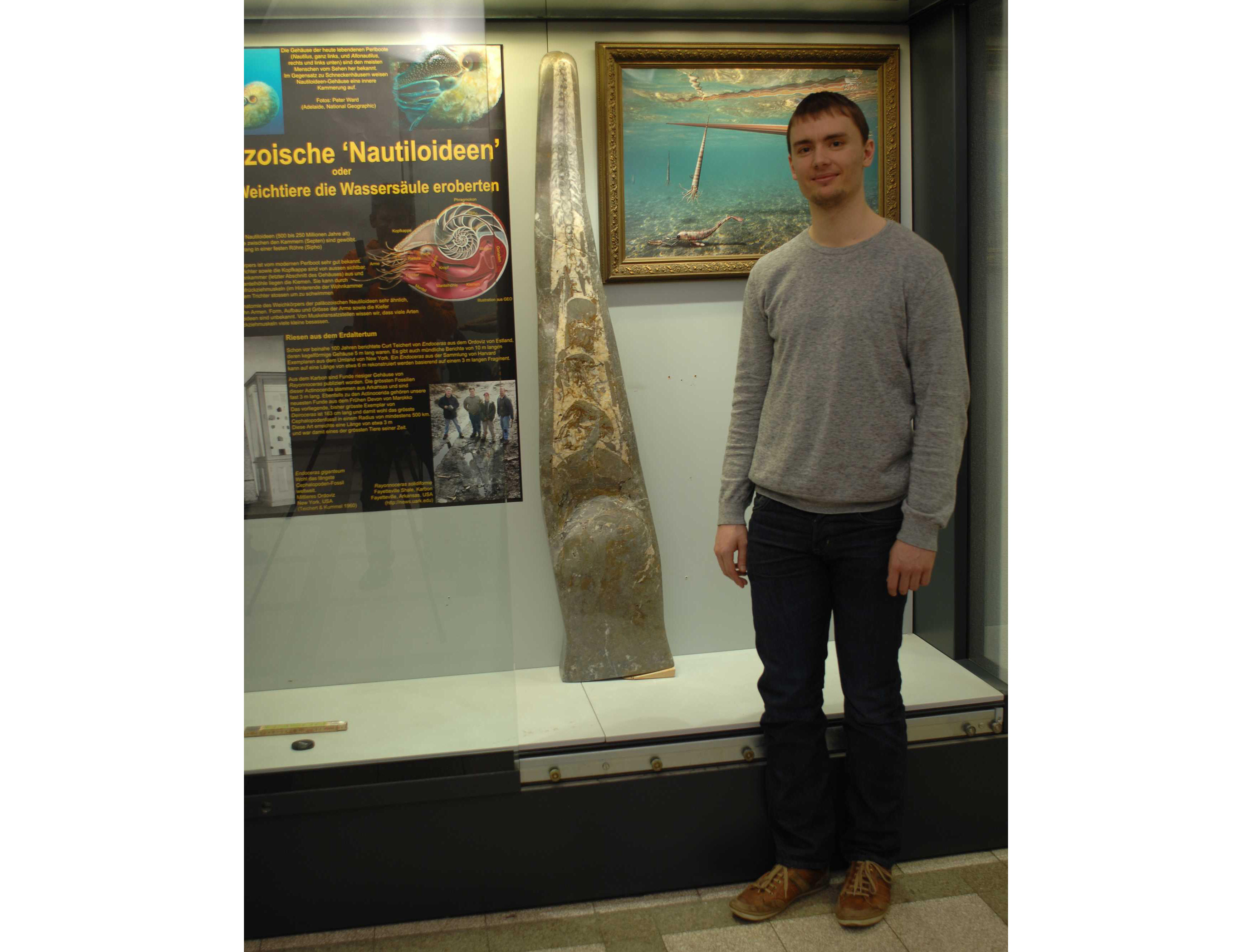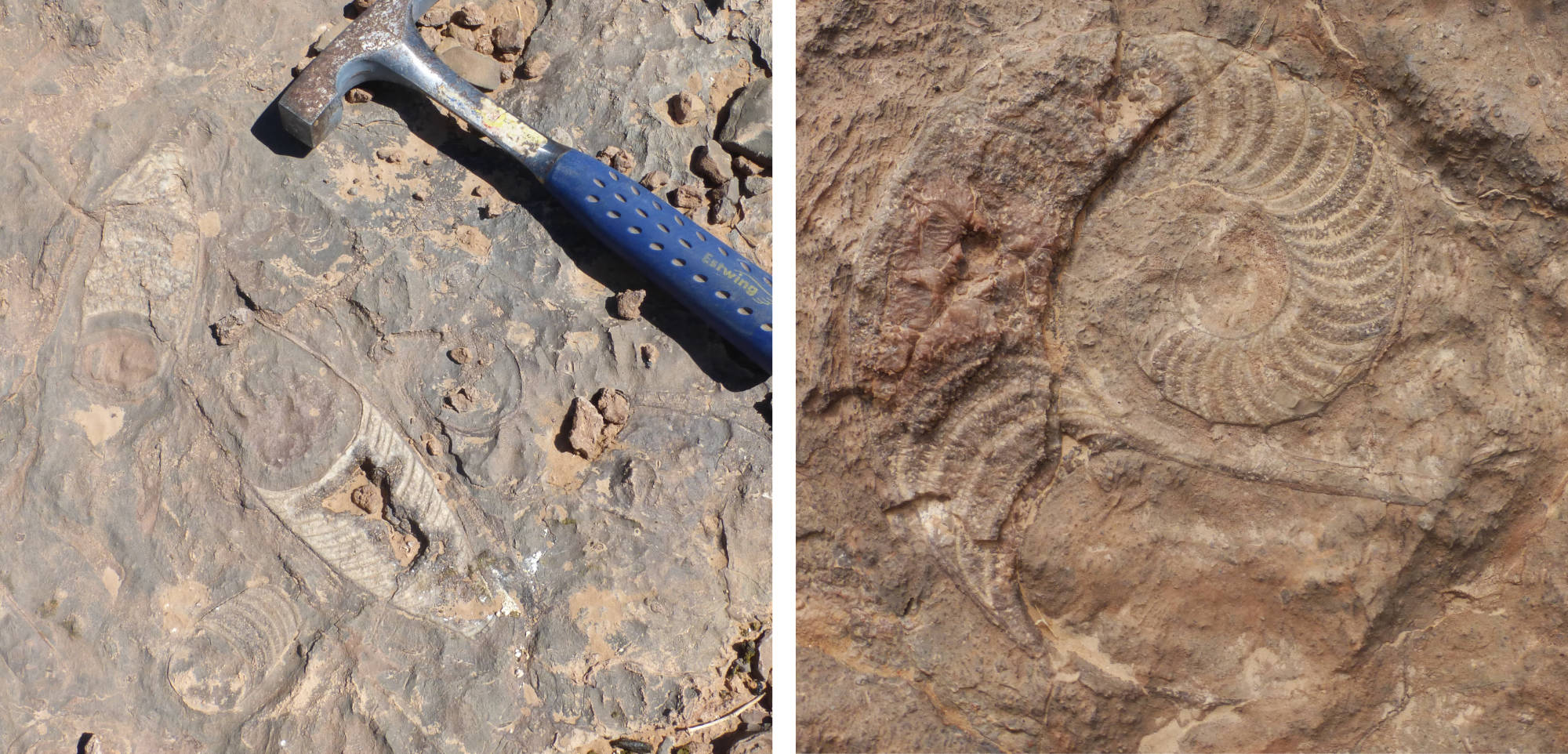Non-ammonoid cephalopods from the Devonian of Morocco
The Devonian of the eastern Anti-Atlas (Morocco) has long been recognised as an excellent area to study various fossil groups, due to the vast extent of exposed fossiliferous outcrops. While ammonoids from this region are quite well-studied, less attention has been paid to non-ammonoid “nautiloid” cephalopods. Prior to this project, there had only been a single major taxonomic study at a single locality, already showing their abundance and undocumented diversity (Kröger 2008).
During my MSc, I investigated changes in body size of straight-shelled (orthoconic) cephalopods from the late Silurian until the Late Devonian in this region, showing that fluctuations are commonly associated with minor extinction events (Pohle & Klug 2018a). During the Emsian (Early Devonian), some actinoceratids could reach very large sizes of more than 2 metres in length when fully reconstructed (Fig. 1).

Fig. 1. A large Deiroceras hollardi in a special exhibition on nautiloids at the Palaeontological Institute and Museum (now Museum of Natural History) of the University of Zurich, in February 2016, with myself as a scale. Photo: Christian Klug.
As part of my subsequent PhD, I studied the rich non-ammonoid faunas of the Tafilalt and Maïder (examples in Fig. 2). This resulted in two taxonomic articles, one where we described the cephalopod fauna at the mud mounds of Hamar Laghdad, including several new taxa (Pohle & Klug 2018b), and a shorter one where we described a new genus of a large oncoceratid (Pohle et al. 2019).

Fig. 2. “Nautiloid” cephalopods from the Middle Devonian of the Tafilalt, Morocco. Left: Abundant oncoceratids in the Givetian at Hamar Laghdad. Right: Rutoceratid in the Eifelian at Jebel Ouaoufilal. Photos: Alexander Pohle.
Additionally, we found a peculiar clustering of pairs of oncoceratids at Hamar Laghdad, which we interpreted as evidence for a semelparous life cycle, i.e., the animals likely reproduced only once and died shortly thereafter (Pohle et al. 2020). This is notable because oncoceratids are assumed to be more closely related to Nautilus, but this reproductive strategy is more similar to what we see in living coleoids, suggesting that the evolution of reproductive strategies in cephalopods is more complex than commonly assumed.
Besides these studies as a lead author, I also contributed as co-author to studies involving cephalopods from the Anti-Atlas (Klug et al. 2018, 2019; Frey et al. 2020).
The non-ammonoid faunas in the Anti-Atlas of Morocco are so rich and diverse but understudied that there is still a lot to discover and I hope to continue this work in the future, as I have collected plenty of undescribed material during the course of my PhD.
References
- Frey, L., Pohle, A., Rücklin, M. & Klug, C. (2020). Fossil-Lagerstätten, palaeoecology and preservation of invertebrates and vertebrates from the Devonian in the eastern Anti‐Atlas, Morocco. Lethaia, 53(2), 242-266. https://doi.org/10.1111/let.12354
- Klug, C., Pohle, A. & Korn, D. (2019). Empty cephalopod conchs as substrates for gastropod eggs from the Hangenberg Black Shale (Late Devonian) of the Maïder Basin (Morocco). Fossil Imprint, 75(1), 59–63. https://doi.org/10.2478/if-2019-0004
- Klug, C., Samankassou, E., Pohle, A., De Baets, K., Franchi, F. & Korn, D. (2018). Oases of biodiversity: Devonian mudmounds at Hamar Laghdad, Morocco. Neues Jahrbuch für Geologie und Paläontologie, Abhandlungen, 290(1–3), 9–48. https://doi.org/10.1127/njgpa/2018/0772
- Kröger, B. (2008). Nautiloids before and during the origin of ammonoids in a Siluro-Devonian section in the Tafilalt, Anti-Atlas, Morocco. Special Papers in Palaeontology, 79, 1-110.
- Pohle, A., Fuchs, D., Korn D. & Klug, C. (2020). Spatial distribution of oncocerid cephalopods on a Middle Devonian bedding plane suggests semelparous life cycle. Scientific Reports, 10, 2847. https://doi.org/10.1038/s41598-020-59507-0
- Pohle, A. & Klug, C. (2018a). Body size of orthoconic cephalopods from the late Silurian and Devonian of the Anti-Atlas (Morocco). Lethaia, 51(1), 126–148. https://doi.org/10.1111/let.12234
- Pohle, A. & Klug, C. (2018b). Early and Middle Devonian Cephalopods from Hamar Laghdad (Tafilalt, Morocco) and remarks on epicoles and cameral deposits. Neues Jahrbuch für Geologie und Paläontologie, Abhandlungen, 290(1–3), 203–240. https://doi.org/10.1127/njgpa/2018/0776
- Pohle, A., Klug, C. & Haas, M. (2019). Gigantism, Taphonomy and Palaeoecology of Basiloceras, a new oncocerid genus from the Middle Devonian of the Tafilalt (Morocco). Swiss Journal of Palaeontology, 138(1), 151–162. https://doi.org/10.1007/s13358-019-00182-8
